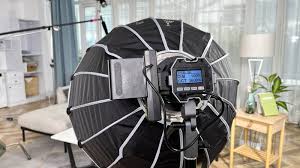Podcast Lighting Setup: Mastering The Art For Your Show

 Jun 17, 2025
Jun 17, 2025
 Lighting
Lighting
When it comes to video podcasts and live streams, lighting is more than just a technical setup; it’s also a part of your show’s brand, visual identity, and storytelling. Just like your logo, color palette, and theme music all create an identity for your brand, having a signature lighting style shapes an experience that your audience can identify with and remember.
If your goal is to make your podcast or streaming show look better, I’ve put together this guide to help you create an intentional and consistent lighting style that’s best suited to your content and personality.
1. Understand how Lighting Contributes to Brand Identity
Lighting conveys mood, tone, and style. A high-key, bright setup indicates energy and positivity. When building your lighting look, ask:
- What emotional tone do I want my show to communicate?
- What type of energy should my lighting convey (warm, cool, vibrant, relaxed)?
- How should my set and host(s) feel visually to the audience?
This clarity will guide every lighting choice you make.
2. Analyze Your Visual Inspiration
Study other podcasts and shows with lighting you admire. Observe how they:
- Place lights on the subject
- Use background and accent lighting
- Mix or match color temperatures
- Control contrast and shadow
- Integrate lighting into their visual brand
Create a mood board of lighting examples that align with your desired brand image. This will serve as a visual guide when setting up your own studio.
3. Choose Your Color Palette
If your show has an established brand palette (logo colors, overlays, and website colors), you can subtly or boldly incorporate these elements into your lighting design.
Common techniques:
- Use RGB LED accent lights or LED strips to add branded color to the background.
- Add practical lights (lamps, signs) that match your palette.
- Consider colored gels on lights or backlights.
Important tip: Keep skin tones natural and flattering. Use branded colors in the background, not on the host’s face.
4. Design the Lighting Layers
A signature look usually involves layered lighting:
- Key Light: Main light on the host. Should match your tone (soft and flattering for lifestyle shows, harder for edgy styles).
- Fill Light: Fills shadows to control contrast.
- Backlight (Hair Light): Creates separation between the host and the background.
- Background Lighting: Adds depth and atmosphere. Colored lights often go here.
Experiment with:
- Light angles and intensity
- Color temperature (cooler vs warmer)
- Shadow placement and softness
- Background brightness vs subject brightness
Document your settings and placements once you finalize a look.
5. Build a Repeatable Setup
Consistency is key to building a signature lighting look.
To achieve this:
- Use light stands and clamps for fixed positions.
- Mark the placement of lights and camera on your floor or desk.
- Write down light intensity, angles, and color settings.
- Control ambient light by using blackout curtains and dedicated studio lights.
A repeatable setup ensures your show looks the same episode after episode, reinforcing brand recognition.
6. Add Unique Visual Touches
To truly personalize your lighting look:
- Integrate a signature background element (neon sign, branded object).
- Use a subtle, recurring light animation or color shift.
- Create depth and layering with foreground and background elements.
- Play with shadows creatively when it fits your tone.
The goal is for viewers to instantly recognize your show’s look, just like they would your logo or intro music.
7. Test, Iterate, and Adapt
Lighting is both a science and an art. Once your basic signature look is built:
- Record test footage and view it on different devices.
- Adjust lights to ensure your style holds up across various screens.
- Solicit feedback from trusted viewers.
Stay open to refining your look over time as your brand evolves.
Conclusion
The lighting setup for your show is one of the most impactful branding tools you can master to elevate the visual experience of your podcast or show. Once you have developed a signature lighting look for your show, based on your brand identity, repeatability, and artistic vision, you not only create a recognizable visual style with your show, but you will also push your content to be recognized in that 'target-rich' environment.
